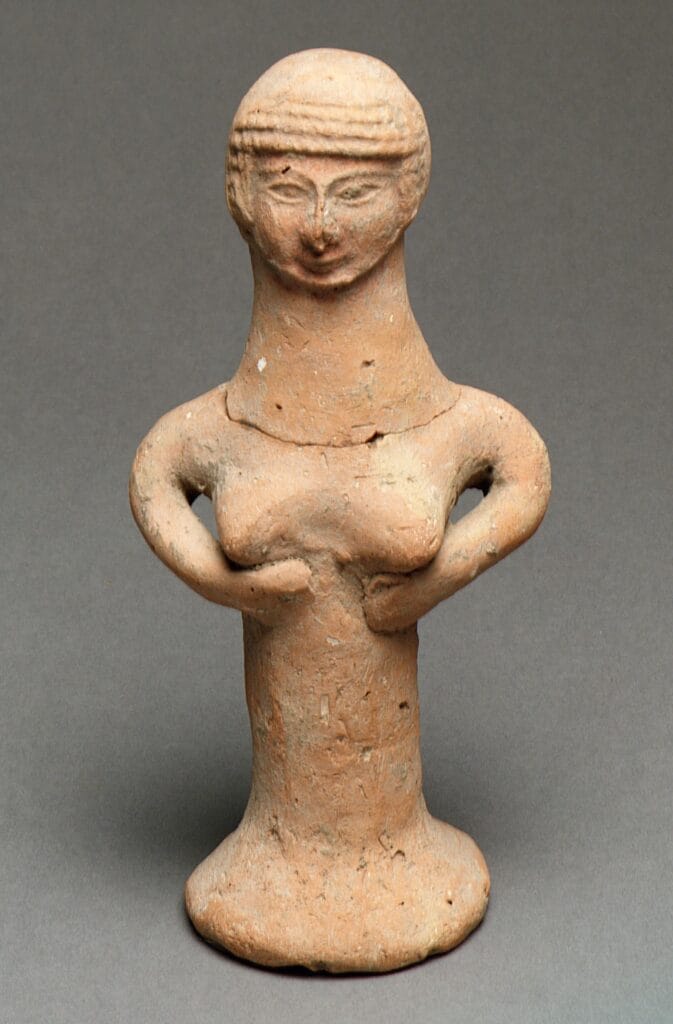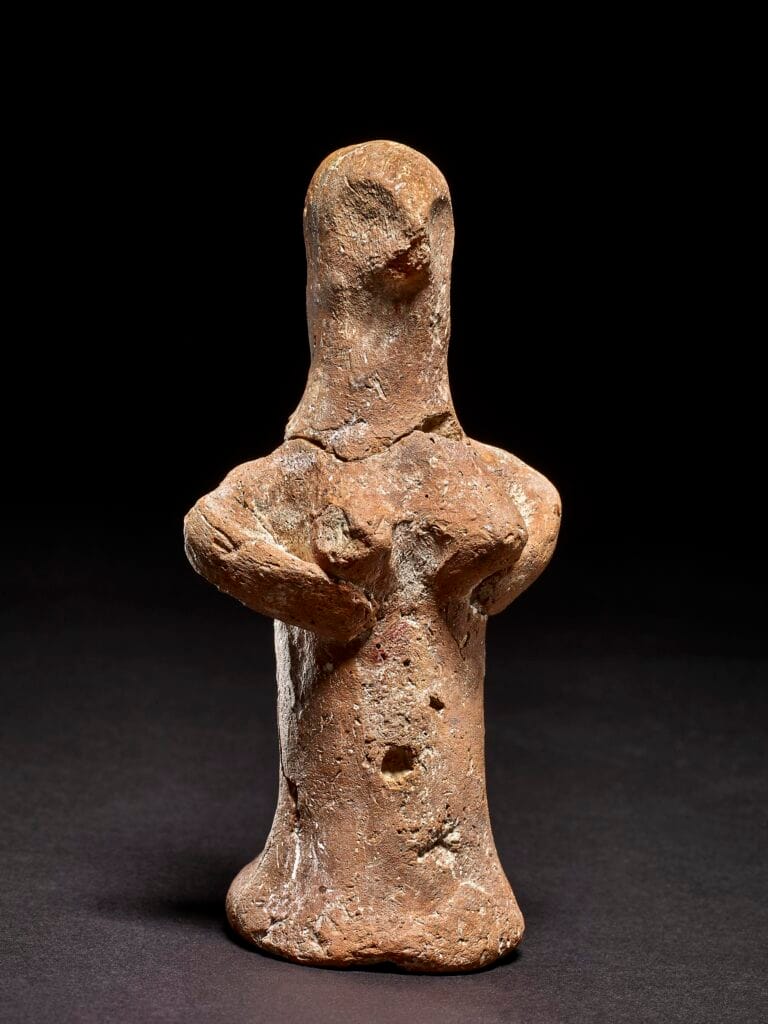This somewhat abstract female figurine (fig. 1) was excavated in the 1930s at the site of Tell ed-Duweir, the ancient city of Lachish in Judah. It is formed from clay and stands around 18 cm tall. The head, reattached to the body since its excavation, was made separately from the base in a mould, and sports an Egyptian-style wig, piercing eyes, and a slight smile. The figurine would have originally been brightly painted, but all that has faded since the eighth or seventh century BC, when it entered the ground.
Unfortunately, exactly where in the ground it was excavated was not recorded, but it is possible that it came from a tomb in which four very similar female figurines were found, along with some musical rattles, figurines depicting a horse rider, some sort of animal, and a bird, as well as a selection of pottery. This figurine was not, therefore, unique.

Far from it. In fact, at every archaeological tell (mounds formed by ancient settlements) in which eighth and seventh century remains of the kingdom of Judah (in the period of 2 Kings and 2 Chronicles) have been excavated, figurines such as this one show up. Some, like figure 1, have moulded heads, others are more rudimentary, with heads formed by pinching the clay at the top of the figure (see fig. 2), but the characteristic cylindrical shape, wide base, and breasts with curved arms resting underneath, are so ubiquitous as to have been given their own acronym JPFs—‘Judaean’ or ‘Judahite Pillar Figurines’.

But what are these JPFs? Portraits of loved ones? Decorative trinkets to place on the mantelpiece? Evidence of an ancient Barbie craze? Objects of religious devotion? The frustrating answer is that we simply don’t know. Or at least, we don’t know for certain. None of these figurines have writing on them, which could help explain what they are. Most of them have not been excavated in the locations in which they were initially placed and used, but were found broken in rubbish heaps, on the floors of houses, or having been reused as building material. What they were originally being used for, and where they were being used, is therefore also difficult to ascertain.
Most scholars don’t think it probable that these figurines were toy dolls. It is unlikely that toys in the ancient world would all be so similar in shape as the JPFs are. They are also rather fragile and seem to have been designed so as to have their back against something, like an item of furniture or a wall, so they were not well suited for being played with.
It is not impossible that these figurines represented loved ones, or other living or deceased women, but their uniformity suggests they were not ‘portraits’ as we would understand the term. The nature of art in the ancient Near East was such that it is also unlikely that the JPFs were purely decorative. To make a representation of something was to somehow make it present and accessible through its depiction. Whatever these JPFs represented, they were most probably thought to be imbued with much greater power and significance than a modern portrait.
Indeed, the overwhelming scholarly opinion is that the Judaean Pillar Figurines performed some sort of religious function. The general assumption is that they were images of a goddess, which would presumably have been placed in shrines within houses and elsewhere, receiving offerings. Some have suggested they represent Ashtoreth, the goddess of the Sidonians worshipped by Solomon. More suggest the goddess Asherah, the famous snare of the Israelites, often worshipped in the form of a wooden symbol or tree. Others have connected the JPFs to the teraphim, or household gods, such as those hidden by Rachel in her camel’s saddle or placed by Michal in David’s bed to deceive her husband’s captors. Yet others have suggested that these were not goddesses, but semi-divine, apotropaic protective figures, believed to ward off evil, or figurines used in exorcistic rituals, thought to be able to absorb a person’s ailments or curses. Exactly who these JPFs represented, or what their function was, is likely to remain speculative, but that they were in some way connected to the sphere of religious belief and practice is more certain.
It should come as no surprise to those familiar with the Old Testament that the people of Judah at this time were worshipping images of a goddess in their homes, or using figurines in magic rituals. After all, it was for such practices that the prophets warned of God’s coming wrath on his people (e.g. Isaiah 44:9-20). King Josiah (641–609 BC) attempted to rid Judah of idolatry, removing ‘the mediums and the necromancers and the household gods and the idols and all the abominations that were seen in the land of Judah and in Jerusalem’ (2 Kings 23:24). But the use of these figurines persisted beyond Josiah’s reign. Indeed, it is only with the exile of Judah to Babylonia, God’s long foretold punishment for idolatry, that these figurines stop appearing in the archaeological record.
November 3, 2023
Notes
Figure 1, Nude female figure, ca. eighth–seventh century BC. The Metropolitan Museum of Art, 34.126.53. Public Domain.
Figure 2, Pottery pillar figurine, 1980,1214.16710 © The Trustees of the British Museum (CC BY-NC-SA 4.0).
